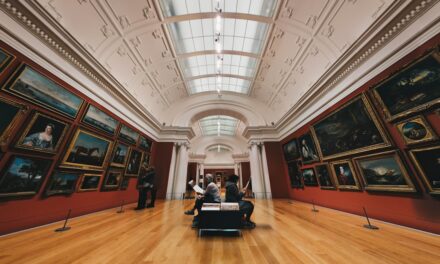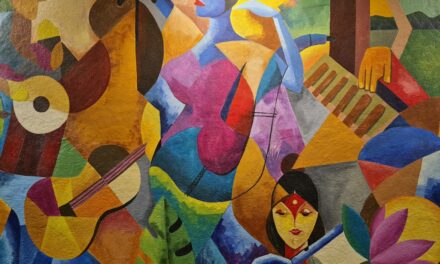In the realm of pencil drawing, the concepts of positive and negative space are fundamental to creating compelling compositions. Positive space refers to the areas of the artwork that are occupied by the subject matter, such as figures, objects, or any focal points that draw the viewer’s attention. Conversely, negative space encompasses the areas surrounding and between these subjects, often serving as a backdrop that can enhance or detract from the overall impact of the piece.
Understanding these two elements is crucial for artists, as they work in tandem to create a cohesive visual narrative. The interplay between positive and negative space can significantly influence the viewer’s perception of a drawing. For instance, a well-defined positive space can stand out dramatically against a thoughtfully rendered negative space, creating a sense of balance and harmony.
Conversely, neglecting the negative space can lead to a cluttered composition that confuses the viewer’s eye. Artists must learn to see beyond the subject itself and appreciate the importance of the spaces that surround it, as these areas can be just as expressive and vital to the overall composition.
Summary
- Understanding positive and negative space is crucial for creating dynamic pencil drawings
- Balancing positive and negative space is essential for a well-composed drawing
- Techniques such as overlapping and varying line weights can help achieve balance in composition
- Utilising contrast in shading and texture can enhance the impact of positive and negative space
- Creating depth and dimension in drawings can be achieved through strategic use of positive and negative space
The Importance of Balancing Positive and Negative Space in Composition
Achieving a harmonious balance between positive and negative space is essential for effective composition in pencil drawing. When these two elements are in equilibrium, they work together to guide the viewer’s eye through the artwork, creating a sense of flow and movement. A drawing that successfully balances these spaces can evoke emotions and convey messages more powerfully than one that does not.
This balance is not merely a matter of aesthetics; it is a fundamental principle that underpins the effectiveness of visual storytelling. Moreover, balancing positive and negative space can help to establish a focal point within a drawing. By strategically placing positive elements against a contrasting negative background, artists can draw attention to specific areas of their work.
This technique not only enhances the visual appeal but also allows for greater narrative depth.
Techniques for Creating Balance in Pencil Drawing Composition
There are several techniques that artists can employ to achieve balance between positive and negative space in their pencil drawings. One effective method is the use of symmetry, where elements are arranged evenly on either side of a central axis. This approach can create a sense of stability and order within the composition.
However, artists should be cautious not to rely solely on symmetry, as it can sometimes lead to predictability. Instead, incorporating asymmetrical balance—where elements are distributed unevenly yet still achieve harmony—can add dynamism and interest to a piece.
By adjusting the size of objects or figures within the composition, artists can create a more engaging visual experience. For example, a large positive shape surrounded by ample negative space can evoke feelings of isolation or grandeur, while smaller shapes clustered together may suggest intimacy or chaos. This manipulation of scale allows artists to convey different moods and themes through their work, making it an invaluable tool in achieving balance.
Utilising Contrast to Enhance Positive and Negative Space
Contrast plays a pivotal role in enhancing the relationship between positive and negative space in pencil drawing. By employing varying degrees of lightness and darkness, artists can create striking distinctions that elevate their compositions. High contrast between dark positive shapes and light negative spaces can produce dramatic effects, drawing the viewer’s attention immediately to the focal points of the drawing.
This technique not only enhances visibility but also adds depth and dimension to the artwork. In addition to tonal contrast, artists can also explore textural contrast to further enrich their compositions. For instance, smooth, polished surfaces juxtaposed with rough, textured areas can create visual tension that captivates the viewer’s interest.
This interplay between different textures within positive and negative spaces can evoke sensory experiences, inviting viewers to engage more deeply with the artwork. By thoughtfully considering contrast in both tone and texture, artists can significantly enhance the impact of their drawings.
Creating Depth and Dimension through Positive and Negative Space
The effective use of positive and negative space is instrumental in creating depth and dimension within pencil drawings. Artists can achieve this by employing techniques such as overlapping shapes or varying line weights. Overlapping positive elements can suggest spatial relationships, allowing viewers to perceive which objects are closer or further away in the composition.
This layering effect not only adds complexity but also invites viewers to explore the artwork more thoroughly. Furthermore, artists can manipulate negative space to enhance depth by using it as a tool for perspective. For example, diminishing the size of positive shapes as they recede into the background can create an illusion of distance.
Similarly, incorporating atmospheric perspective—where colours become lighter and less saturated with distance—can further enhance this sense of depth. By skillfully utilising both positive and negative spaces in these ways, artists can transform flat drawings into dynamic representations that engage viewers on multiple levels.
Experimenting with Different Compositional Arrangements
One of the most exciting aspects of working with positive and negative space in pencil drawing is the opportunity for experimentation with compositional arrangements. Artists should feel encouraged to explore various layouts and configurations to discover what resonates most effectively with their vision. This experimentation might involve shifting elements around within the composition or even altering their scale or orientation to see how these changes affect the overall balance between positive and negative spaces.
Additionally, artists can benefit from studying works by other artists who have successfully navigated these compositional challenges. By analysing how different arrangements impact the viewer’s experience, artists can gain insights into their own work. This process of exploration not only fosters creativity but also deepens an artist’s understanding of how positive and negative spaces interact within their compositions.
Using Negative Space to Direct the Viewer’s Eye
Negative space is not merely an empty void; it serves as a powerful tool for directing the viewer’s eye throughout a drawing. By strategically shaping negative spaces around positive elements, artists can guide attention towards specific areas of interest or create pathways for visual exploration. For instance, an elongated negative space leading towards a focal point can create a sense of movement that draws viewers in, encouraging them to engage more intimately with the artwork.
Moreover, artists can utilise negative space to create visual tension or intrigue by leaving certain areas open or ambiguous. This intentional use of emptiness invites viewers to fill in the gaps with their imagination, fostering a deeper connection with the piece. By recognising the potential of negative space as an active participant in composition rather than a passive background element, artists can enhance their ability to communicate ideas and emotions effectively.
Achieving Harmony and Unity in Pencil Drawing Composition
Ultimately, achieving harmony and unity in pencil drawing composition hinges on the thoughtful interplay between positive and negative space. When these elements are balanced effectively, they create a cohesive whole that resonates with viewers on both emotional and intellectual levels. Artists should strive for a sense of unity by ensuring that all components of their drawing work together seamlessly—this includes considering how shapes, lines, textures, and tones interact within both positive and negative spaces.
To cultivate this harmony, artists may find it beneficial to step back from their work periodically during the creative process. This practice allows for a fresh perspective on how well positive and negative spaces are functioning together within the composition. By remaining open to adjustments and refinements, artists can ultimately achieve a level of unity that elevates their drawings from mere representations to evocative works of art that leave a lasting impression on viewers.
In conclusion, understanding and mastering the relationship between positive and negative space is essential for any artist seeking to create impactful pencil drawings. Through careful consideration of balance, contrast, depth, experimentation, directionality, and unity, artists can harness these concepts to enhance their compositions significantly. As they continue to explore this dynamic interplay, they will undoubtedly discover new ways to express their artistic vision while captivating audiences with their work.
In a recent article on political statements in street art, the importance of balancing positive and negative space in pencil drawing composition was highlighted. The article discussed how artists use their work to make powerful statements and convey messages through imagery. By carefully considering the use of positive and negative space in their compositions, artists can create impactful pieces that resonate with viewers and spark conversations about important social and political issues. This connection between pencil drawing composition and activism through art demonstrates the power of visual communication in conveying powerful messages.


